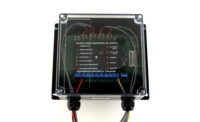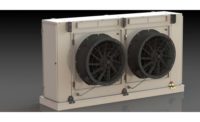How walk-in frame systems deliver dynamic duo for refrigerated walk-in coolers, freezer units
The new frame/rail system is a true revolution in walk-in cold-storage design and operations.

Over the years, there have been many historically significant duos – Ruth and Gehrig in baseball, Martin and Lewis in comedy, Batman and Robin in crime fighting, chocolate and peanut butter in anything. That, however, has not been the case in frame and rail systems for use in the refrigerated walk-in cooler and freezer units in supermarkets and food manufacturing plants.
Until now.
Traditionally, wood has been the material of choice for walk-in unit frame systems, and has performed fairly well, especially structurally, as it’s able to withstand the daily punishment to which walk-in units can be susceptible. The area where wood framing falls short is in its R-value, or the ability to resist the intrusion of exterior heat and condensation development, which can negatively affect the walk-in unit’s cooling or freezing capabilities and shorten its operational lifespan.
An R-value revolution
Choosing between R-value and span strength is not a choice that operators who deploy walk-in storage units need to make anymore. The reason is the development of an innovative new framing system for use in conjunction with walk-in cooler and freezer thermal-envelope wall, ceiling and floor panels.
This new framing system’s design combines the structural strength of wood framing with the thermal performance of polyurethane insulation. It features a foam-frame component with a structural element embedded in it, resulting in a framing system that increases walk-in unit R-values to a level that significantly slow the rate of heat flow and condensation formation, while limiting issues concerning life-cycle performance that can plague traditional plain wood-framed systems.
The key to the improved performance of the new frame system is a method of construction that injects a polyurethane foam insulation jacket around the structural member. The polyurethane is made with a blowing agent that can form a rigid plastic, but only 3% of the material in the foam insulation is a solid. The other 97% consists of millions of miniscule air bubbles that have the blowing-agent gas inside them. These air bubbles better resist the conductance of heat when compared to wood.
Additionally, the density of the polyurethane foam is only 5 pounds per cubic foot (lbs/ft3). By comparison, wood framing weighs between 27-30 pounds ft3, making it up to 15 times denser than the polyurethane foam. The result is using polyurethane foam gives the new frame an R-value of R5.9 per inch of thickness, while the typical R-value of wood is R1.2 per inch of thickness, making the new system around 5 times more resistant to heat flow than wood.
Overall, there are four main benefits for operators who outfit their walk-in coolers and freezers with the new frame/rail technology:
- Energy savings. A high volume of heat that flows into the walk-in unit will force the refrigeration system to work harder to remove it. If less heat is flowing into the unit, there is less that needs to be removed, which means the refrigeration system doesn’t work as hard. This requires less electricity to power the system, which lowers utility costs.
- More airtight construction. When two pieces of wood are joined together in a framing system, there will be a temperature difference at the joint. It is in this area where the temperature is lower, that the heat will conduct at a greater rate. The new rails use a tongue-and-groove connection that fits together more snugly at the joints than wood. This allows the frame components to essentially seal themselves through a locking action that restricts moisture vapor from entering into the center of the panel joint.
- Warmer joint surfaces. With less heat transmitting through the new frame, the outside surface of the joint stays warmer, thereby significantly reducing the possibility of condensation formation in high-humidity environments.
- Energy-efficiency standards. The U.S. Department of Energy (DOE) has created an energy-efficiency standard for the insulation used in constructing the walk-in unit’s walls and ceiling. The minimum R-value for the freezer wall and ceiling insulation must be R32. However, walk-ins built with wood-only frames will allow a level of heat conductance that can reduce the overall R-value to as low as R21. Operators can get an assist in maintaining – or improving – the R32 R-value threshold by using the new framing and rails in the construction of their walk-in units.
Considering energy use
Specific to the new framing system’s energy-saving capabilities, third-party-verified tests show that a 5-inch thick frame/rail featuring the new wood/foam construction will allow a walk-in freezer to deliver an average savings of 9.05 kilowatt (kWh) per day of operation for every 1,000 square feet of panel surface when compared to the performance of a 5-inch thick wood frame/rail. That daily savings equates to 3,303 kWh of energy savings per year for every 1,000 square feet of cooler and freezer panel surface.
The average cost of a kWh of electricity in the United States, as of March, was 13.19 cents, according to ElectricChoice.com, Tyler, Texas. At that cost and the rate of kWh savings of 9.05 cents per day, the daily savings is $1.19. At that rate, the annual kWh savings will be $434.35 per every 1,000 square feet of panel surface.
Like Batman and Robin, the teaming of wood and foam in the frame system creates a dynamic duo that can battle the never-ending assault of exterior heat and humidity. The new frame/rail system is a true revolution in walk-in cold-storage design and operations, as it offers the structural benefits of wood combined with the insulative properties of foam. This is truly a new duo that has the potential to go down in history.
Looking for a reprint of this article?
From high-res PDFs to custom plaques, order your copy today!





